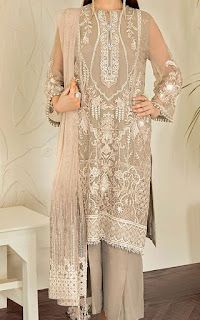Chiffon is Compatible with Elegance in the Fashion Industry
What is Chiffon?
Chiffon is referred to a wide range of multiple sorts of garments, most of which hold different attributes. That kind of material is translucent, which implies that one with a basic weaving it is lightweight and moderately-transparent.
History of Chiffon:
This form of the material was primarily created from silk. Since it was first branded throughout the 19th century, it was both costly and in plentiful supply amongst privileged women in the United States and Europe.
Chiffon is from French and expresses technically as "sheet" or "cloth," and yet
this term has become associated with any luxuriant, pure material spun into a
specific feature.
Characteristics of
Chiffon
In the world of fashion, Chiffon is correlated with sophistication. This floaty, staggering fabric is also used to append a bit of elegance in luxurious materials such as casual clothing or nightwear, as it drapes possibly the best. Chiffon has a lightweight fabric and a moderately-mesh
woven that further provides the structure a translucent, chic attractiveness and
makes it a little bit rugged to the look. The chiffon dresses
are easy to wear and are great for summers.
Georgette vs Chiffon
Weaving silk also makes use of a specific fabric, also known as
georgette. It's a smoother and much more transparent fabric-related fabric.
Nevertheless, georgette is often used to weave silk. It's a more beautiful and
more transparent fabric, but it always drapes like Chiffon. Synthetic fabrics
like cotton make the material smoother and render the Chiffon even less springy.
Some additional features
Chiffon is made and used an overlapping process to weave yarns.
Elevated-twist fabrics have been used, meaning the fabrics are respectively stretched; culminating in the decorative stitching's mild drooping and producing
a lighter collapsing impact in different forms. That also triggers the material
to sound and move somewhat coarse. You will see a translucent mesh impact as you
keep the Chiffon up to the light.
Polyester chiffon and
silk chiffon
Polyester chiffon and silk chiffon would both be textile alternatives which are very common. Although costs aren't a concern, designers usually prefer to choose silk chiffon due to its high price. Nevertheless, due
to its durability and much-reduced price, polyester chiffon is much more commonly used-despite becoming more challenging to stain.
Pros
- Feeling luxury
- Flashy appearance
- Comfy on the skin
- Drape light
- Some stretch
- Natural Textile
Cons:
- Not too polyvalent
- Can be hard to navigate
Handling Chiffon is
complicated
Working with a sturdy fabric seems complicated because it has a
slippery smoothness. Whereas the material is being cut or sewn, weavers consider placing the non-slippery layer above to get the clasp suitable. To this end, the tailor layer sheet across both sides of the fabric which serves to retain the
material together before the method of knitting or sewing. The rough newspaper layer keeps the cloth in position.
Conclusion
You will check the entire garment before purchasing chiffon fabric. Whether the seams are irregular, this means the material may have been treated or folded incorrectly. While the use of subtle gestures can effectively
repair slight drops and scrapes, you should stop purchasing a bit of cloth that
has extreme tickling. Selecting the perfect fabric will help you build a stylish
item.
Follow Us: Facebook, Twitter, Pinterest, Google+ and Instagram.




Comments
Post a Comment